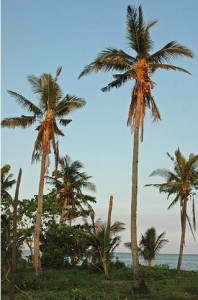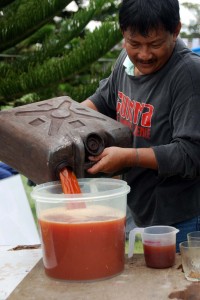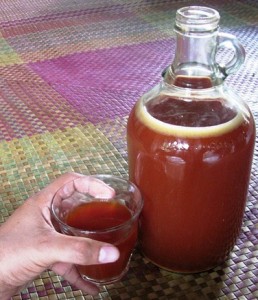Coconut Wine – A Type of Palm Wine
 Palm wine (Coconut Wine) also called palm toddy and called “kallu”, or merely toddy, is an alcoholic beverage generated from the sap of numerous animals of palm tree such as the palmyra, and coconut palms.
Palm wine (Coconut Wine) also called palm toddy and called “kallu”, or merely toddy, is an alcoholic beverage generated from the sap of numerous animals of palm tree such as the palmyra, and coconut palms.
Coconut Wine tuba beverage is common in various parts of Asia and Africa, and goes by different names, such as emu and oguro in Nigeria, nsamba in Democratic Republic of the Congo, nsafufuo in Ghana, kallu in South India, tuak in North Sumatra, Indonesia, mnazi in Mijikenda, Kenya goribon (Rungus) in Sabah, Borneo, and tuba in the Philippines, Borneo and Mexico.
If you want to buy Philippines’ Coconut Wine, also known as Lambanog (Distilled Tuba), CLICK HERE.
Coconut Wine tuba is even ingested in Sri Lanka and Myanmar. Production of coconut wine has indeed contributed to the endangered status of some palm species such as the Chilean wine palm (Jubaea chilensis).
Coconut Wine Tuba in the Philippines
In the Philippines, coconut wine tuba refers both to the freshly collected sweetish sap and the one by having the red lauan-tree tan bark colorant.
In Leyte, the coconut wine tuba is matured for up to one to 2 years such that an echoing ring is made when a glass container is tapped explanation required; this variation of tuba is called bahalina.
Coconut Wine Tuba Tapping
 The sap is extracted and collected by a tapper. Commonly the sap is compiled from the cut flower of the palm tree. A compartment is fastened to the flower stump to collect the sap. The white liquid that at first gathers has a tendency to be extremely sweet and non-alcoholic before it is fermented. An alternate technique is the felling of the whole tree. Where this is practiced, a fire is occasionally lit at the cut end to help with the assortment of sap.
The sap is extracted and collected by a tapper. Commonly the sap is compiled from the cut flower of the palm tree. A compartment is fastened to the flower stump to collect the sap. The white liquid that at first gathers has a tendency to be extremely sweet and non-alcoholic before it is fermented. An alternate technique is the felling of the whole tree. Where this is practiced, a fire is occasionally lit at the cut end to help with the assortment of sap.
Coconut wine tapping is mentioned in the novel Things Fall Apart by the Nigerian writer Chinua Achebe and is central to the plot of the groundbreaking novel The Palm Wine Drinkard by Nigerian author Amos Tutuola.
In parts of India, the unfermented sap is called neera (padaneer in Tamil Nadu) and is cooled, saved and circulated by semi-government agencies. A little lime is included in the sap to prevent it from fermenting. Neera is said to consist of lots of nutrients featuring potash.
Coconut sap starts fermenting immediately after assortment, due to natural yeasts in the air (typically spurred by residual yeast left in the gathering container). Within two days, fermentation yields a fragrant wine of up to 4 % liquor content, mildly intoxicating and sweet.
The coconut wine tuba may be enabled to ferment longer, up to a day, to yield a stronger, more sour and acidic taste, which some folks favor. Longer fermentation creates vinegar instead of stronger wine, known as Lambanog.
CLICK HERE to buy and taste ArchipelaGOLD,flavored Philippine Lambanog.
In Africa, the sap is use to create coconut wine tuba and is most frequently taken from wild datepalms such as the silver date palm (Phoenix sylvestris), the palmyra, and the jaggery palm (Caryota urens), or from oil palm such as the African Oil Palm (Elaeis guineense) or from Raffia palms, kithul palms, or nipa palms.
In India and South Asia, coconut palms and Palmyra palms such as the Arecaceae and Borassus are favored. In southern Africa, palm wine (ubusulu) is produced in Maputaland, an area in the south of Mozambique between the Lobombo mountains and the Indian Ocean.
It is mainly produced from the lala palm (Hyphaene coriacea) by cutting the stem and compiling the sap.
In part of central and western Democratic Republic of the Congo, palm wine is called malafu. There are four types of coconut wine tuba in the central and southern DRC. From the oil palm comes ngasi, dibondo comes from the raffia palm, cocoti from the coconut palm, and mahusufrom a short palm which grows in the savannah areas of western Bandundu and Kasai provinces.
In Tuvalu, the procedure of making toddy can plainly be viewed by having tapped palm trees that line Funafuti International Airport.
In some areas of India, coconut wine tuba is evaporated to create the unrefined sugar called jaggery.
If you are looking for a Coconut Wine with a taste to die for, CLICK HERE.
Coconut Wine Tuba Distillation – Lambanog
Local Distillation of Burukutu in Ghana
Coconut wine tuba might be distilled to generate a stronger refreshment which is Lambanog goes by different names baseding on the region (e.g., arrack, village gin, charayam, and nation whiskey). Throughout Nigeria, this is typically called ogogoro. In parts of southern Ghana distilled coconut wine is called akpeteshi or burukutu.
In Togo it is called sodabe, in the Philippines it is called lambanog, while in Tunisia it is called Lagmi.
Social role of Coconut Wine
In India, coconut wine or toddy is served as either neera or padaneer (a sweet, non-alcoholic beverage stemmed from fresh sap) or kallu (a sour drink made from fermented sap, yet not as tough as wine). Kallu is in most cases drunk soon after fermentation by the end of day, as it becomes more sour and acidic day by day. The drink, like vinegar in taste, is thought of to have a short-lived shelf life. explanation needed Nonetheless, it could be refrigerated to extend its life.
In Karnataka, India, coconut wine is in most cases offered at toddy shops (known as Kalitha Gadang in Tulu, Kallu Dukanam in Telugu, Kallu Angadi in Kannada or “Liquor Shop” in English).
In Tamil Nadu, this beverage is currently outlawed, though the legality fluctuates with politics. In the absence of legal toddy, moonshine distillers of arrack often offer methanol-contaminated liquor, which are able to have lethal effects. To discourage this practice, authorities have definitely pushed for inexpensive “Indian Made Foreign Liquor” (IMFL), much to the dismay of toddy tappers.
If you want to buy Philippines’ Coconut Wine, also known as Lambanog, CLICK HERE.
In the state of Andhra Pradesh (India), coconut wine is a well-liked drink in rural parts. The kallu is compiled, distributed and offered by the folks of a specific caste called Goud or Gamalla (Goundla). It is a big business in the cities of those areas. In towns, people consume it every day after work.
There are two fundamental variations of kallu in Andhra Pradesh, specifically Thadi Kallu (from Toddy Palmyra trees) and Eetha Kallu (from silver date palms). Eetha Kallu is remarkably sweet and less intoxicating, whereas Thati Kallu is stronger (sweet in the morning, becoming sour to bitter-sour in the night) and is extremely intoxicating. Folks savor kallu right at the trees where it is brought down. They drink from leaves by holding them to their mouths while the Goud pours the kallu from the binki (kallu pot). There are different variations of toddy (kallu) according to the period:
In Kerala,toddy is sold under a licence released by the excise department and it is a sector having more than 50,000 staff members by having a well being board under the labor unit. It is even made use of in the preparation of a soft selection of Idli, which is well-known in the parts of Karnataka and Goa in India.
If you want to buy Philippines’ Coconut Wine (Distilled Tuba), also known as Lambanog, CLICK HERE.



